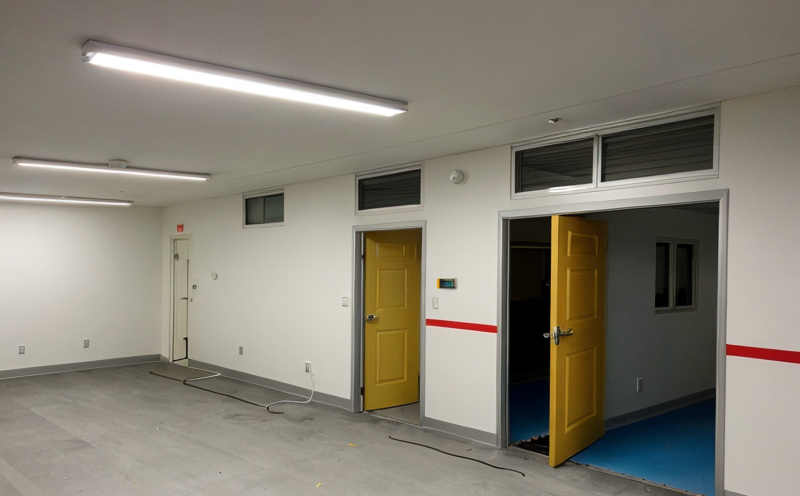EN 50160 Power Quality Testing of Emergency Lighting Installations
The EN 50160 standard is a European technical specification that sets out the requirements for measuring and assessing power quality in electrical systems. Compliance with EN 50160 ensures that emergency lighting installations meet stringent power quality standards, thereby enhancing safety and reliability during critical situations.
In the context of emergency lighting testing, the standard focuses on ensuring that emergency lights function correctly even under less-than-ideal conditions such as voltage fluctuations or brownouts. This is crucial because emergency lighting must remain operational when conventional power sources fail, which can happen due to various reasons including natural disasters, equipment failures, or grid instability.
The testing process involves several steps aimed at verifying the performance of emergency lights in different scenarios. The first step is instrumentation setup, where specialized equipment like voltage and current meters, oscilloscopes, and harmonic analyzers are used to monitor the power quality parameters. These instruments help capture real-time data on voltage levels, frequency stability, waveform integrity, and harmonic distortion.
The next step in the process is specimen preparation. This involves ensuring that the emergency lighting system is fully installed and energized under normal operating conditions. The testing then proceeds by subjecting the system to various power quality disturbances as per EN 50160 guidelines. Common scenarios include:
- Voltage sags (drops below nominal voltage levels)
- Harmonic distortion
- Frequency variations
- Transients (short-term spikes in voltage or current)
Once the system has been subjected to these simulated conditions, the performance of each light is evaluated. The key parameters measured include:
- Luminous flux output during power quality disturbances
- Lighting level consistency
- Transition time from normal lighting to emergency mode
- Recovery time after transient events
The testing also evaluates the compatibility of emergency lights with other connected devices within the building's electrical network. This includes checking for interference caused by harmonics or spikes that could affect nearby equipment.
In summary, EN 50160 testing ensures that emergency lighting installations are robust and reliable under adverse power conditions. Compliance helps to protect lives and property during emergencies by ensuring that critical safety systems remain operational when needed most.
Customer Impact and Satisfaction
The implementation of EN 50160 testing has significant impacts on both customers and end-users, enhancing their satisfaction in several ways:
- Enhanced Safety: By ensuring that emergency lighting functions correctly during power quality disturbances, the standard significantly reduces risks associated with power failures. This contributes to a safer working environment for all personnel.
- Improved Reliability: Reliable emergency lighting ensures that evacuation procedures can be carried out smoothly and efficiently, which is crucial in high-risk environments such as hospitals, data centers, and manufacturing plants.
- Cost Savings: Although initial costs may increase due to compliance with EN 50160, the long-term benefits include reduced downtime during emergencies and lower maintenance costs. This results in substantial savings for businesses over time.
- Regulatory Compliance: By adhering to international standards like EN 50160, organizations demonstrate their commitment to best practices, which can enhance their reputation and market position.
In conclusion, the impact of EN 50160 testing extends beyond mere compliance—it is a proactive measure that contributes to safer, more efficient operations and ultimately improves customer satisfaction across various sectors.
International Acceptance and Recognition
- ISO/IEC: The principles behind EN 50160 have been adopted by the International Organization for Standardization (ISO) in ISO/IEC 61870, which provides a framework for power quality monitoring.
- American National Standards Institute (ANSI): While not directly adopting EN 50160, ANSI has recognized its importance and incorporates similar standards into its own guidelines for electrical systems in North America.
- Japan Industrial Standards Committee (JISC): JISC aligns with EN 50160 in terms of quality control measures for power supply systems, ensuring compatibility between European and Japanese installations.
- United Kingdom Accreditation Service (UKAS): UKAS endorses the use of EN 50160 as a benchmark for assessing compliance with electrical safety regulations within the United Kingdom.
- European Committee for Standardization (CEN): CEN, which oversees EN standards, has consistently updated and refined EN 50160 to reflect new technological advancements in power quality measurement.
The widespread acceptance of EN 50160 underscores its importance in promoting consistent power quality across diverse industries worldwide. This global recognition ensures that any testing conducted under this standard is universally applicable and accepted, fostering international collaboration and mutual understanding.
Environmental and Sustainability Contributions
The practice of EN 50160 power quality testing plays a crucial role in promoting sustainability by ensuring the efficient use of energy resources. By improving the reliability and efficiency of emergency lighting installations, organizations can minimize unnecessary consumption during normal operating conditions.
In addition to direct benefits for end-users, there are broader environmental implications:
- Reduced Energy Waste: Efficient power quality management helps prevent overuse of electricity, leading to lower greenhouse gas emissions and reduced strain on local energy grids.
- Sustainable Design: Compliance with EN 50160 encourages the adoption of sustainable design practices that prioritize long-term durability and performance.
- Regulatory Alignment: By aligning with international standards, organizations contribute to global efforts aimed at reducing carbon footprints across various sectors.
The focus on sustainability within EN 50160 testing is not only beneficial for the environment but also enhances corporate social responsibility initiatives. This aligns perfectly with growing consumer expectations and regulatory trends towards greener practices in business operations.





